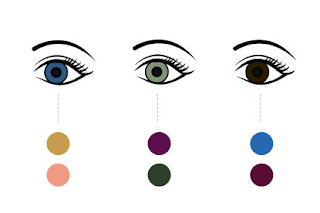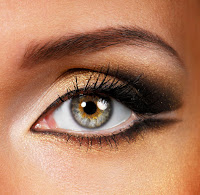You could say that I have a love/hate relationship with makeup.
Some days I enjoy playing with all the different colors and get excited when my
smoky eye turns out perfectly.
But then there are those days when my liner refuses to go on
straight, my bronzer makes me look like an Asian Snookie, or my lashes refuse
to curl. That's when I want to toss my makeup bag out my bathroom window.I had one of those days last week, and after walking into work
wearing twovery different winged tips on my eyes, my editor assigned me
a new story: Go to makeup school and write about it. Want to see the best techniques I picked up without spending the
thousands of dollars (and crazy amount of time) it takes to go to makeup school
yourself?
Lesson No. 1: Spend some bucks on your tools
At Napoleon Perdis' Makeup Academy in Hollywood, Rebecca Prior,
NP's National Educator, begins the first lesson by introducing us to our tools.
"To me, tools and products are equally as important as the makeup skills
that you have," she says. For example, let's say you were using mediocre
brushes, mediocre products, and had average skill. Just by improving the
quality of your brushes and using richer pigmented products, the application
would immediately be better, even without improving your technique. So if you
really want to apply your makeup like a pro, Los Angeles-based educator Felicia
Alva says, "Do what the professionals do: Use the proper brushes for
application."
Here are the eight basic brushes you need:
1. Foundation brush
2. Concealer brush
3. Fluffy powder brush
4. Blush brush
5. Small blending brush
6. Flat eyeshadow brush
7. Precision angle brush
8. Lip brush
Once you have your tools, you need to know how to hold them.
Make Up For Ever educator Lijha Stewart says, "Where you hold a brush on
the handle affects your control. The closer your fingers are to the barrel (the
silver section beneath the brush head), the more pressure you put on the brush
head and vice versa." In general, if you want to apply color evenly, place
your fingers on the center of the brush handle. Another tip: You can easily
turn a fluffy brush into a flat, angled brush by wrapping your hand around the
bristles and flattening them.
Lesson No. 2: Mix primer with your foundation
I'm sitting in Make-up Designory's Beauty 101 classroom and I'm
anticipating today's lesson to be quite the bore-fest. I'm barely paying
attention as lead instructor Gil Romero goes through the three different types
of foundation: liquid, powder, and cream. Yawn. Wake me up when I'm going to
learn something new.
It seems like Romero read my mind, because he immediately hit me
with this tip: "You can wear cream foundation as is for opaque, full
coverage, or you can break it down to be more translucent by mixing it with
some primer," he says. What? Isn't primer only supposed to go on before
foundation? But Romero says this is a surefire way to retain the foundation's
coverage without looking caked on. Plus, you get to reap the long-lasting
durability that cream foundation has over liquids and powders. Prior says this
also helps the makeup blend seamlessly with the first layer of primer on your
skin.
I raise my hand at this point and ask if cream foundation is OK
for oily skin. This is a selfish question, because I struggle with a mid-day
oily T-zone. Make-up Designory educator Yvonne Hawker (who also wrote the
school's textbook) says everyone can use cream foundation, but those with oily
skin should use a damp sponge to apply it. Most foundations have oil in its
formula to give the coverage blend-ability. Using the sponge will "pick up
the pigment, but not the oil in the foundation." You'll still get great
coverage, but not the shine.
For dry or combination skin types, "use your foundation
brush and buff the foundation onto the skin, concentrating on the center of
your face, which is typically where your skin has the most discoloration,"
says Hawker. "The further you get from the center, the less coverage you
want."
 Lesson No. 3: Love your flaws —
then conceal them
Lesson No. 3: Love your flaws —
then conceal them
It's day 3 at makeup school and there's a color wheel on the
whiteboard. "The key to being a successful makeup artist is being able to
identify someone's undertones and know how to manipulate the color wheel to get
rid of unwanted color," says instructor Gina Sandler.
And when Sandler says "unwanted color," I immediately
tune in because I want to learn how to cover up my zits, the stubborn redness
around my nose, and the bluish hues under my eyes. She says opposite colors
cancel each other out, so green-pigmented concealer covers redness, and orangey
concealer removes blue. "If you use your beige concealer, it'll only make
those areas look muddy," says Prior.
Once Sandler shows us how she gets rid of zits, redness around
the nose, and under-eye bags on one of the students, she then pairs us off and
has us practice on each other's makeup-free faces. Immediately, all of my
insecurities start bubbling up. My bags, my zits, my dark spots … is someone
seriously going to be inches away from them? Then one of the students says, "Ugh,
I'm so ugly." Sandler responds, "No, you're so cute! You all
are!" It's makeup school, but it starts to feel more like we're in a group
therapy session. Sandler says practicing on each other is key because you
quickly learn how to deal with all types of skin tones and facial features,
which you will have to become comfortable with if you want to be a professional.

Lesson No. 4: Fix your face shape
So here's a not-so-secret confession: I hate my face. It's
rounder than a Cabbage Patch Kid's and I can't stand my button nose. So when
Prior says today's lesson is learning how to contour properly so you can alter
your face shape and features, I'm so eager to learn I actually volunteer to be
her model at the front of the class. "Contouring is the art of
highlighting and shading," says Prior. "Anything that is lighter than
the skin tone will make an area more prominent, anything darker will make that
area recede." Here's how you can easily alter your face:
If you have a round face and want to make it look more oval:
Apply a bronzer a shade or two darker than your skin tone in a "3"
shape alongside your face: on your temples, the hollow of your cheeks, and your
chin. If you have a prominent forehead: Shade around the outer edge of your
forehead along your hairline to minimize the area with bronzer. If you have a
flat or wide nose: Shade alongside your bridge starting from your inner brows.
Then highlight right on the center of your nose.
If gravity is taking a toll and your cheeks are sagging: Apply a
highlighter just above your cheekbone all the way to your temple. Use a blush
directly on the cheekbone, then use a bronzer in the hollow of the cheek,
underneath your bone.
And if you really want to make your contouring stand out, use a
sparkly highlighter, which will reflect the most light. Then for your bronzer,
go for a matte finish, which will absorb light and create a stark contrast.

Lesson No. 5: Make your eyes pop by changing their shape
Just like how I learned to use highlights and shadows to contour
my face, I found out that I can use the same info to alter my eye shape, too.
Whether you have drooping lids, narrow-set eyes, or they're simply too small,
you can use your knowledge of light and shadow to change them.
If you want to add definition: Sweep a light bronzer through the
crease of the eye, which is halfway between the lashline and the eyebrow.
"As you age, the eye area loses elasticity, and things aren't as shapely
as they used to be," says Prior. "This technique is great for mature
skin, to give the face more definition." A tip for you blue-eyed girls: An
orange-y bronzer in your crease will make your eyes even bluer.
If you have narrow-set eyes: To elongate your eye width, apply a
black liner to the outer half of both your upper and lower lashlines,
connecting at the outer corner.
If you have drooping, heavy lids: Use what you just learned
about highlights and shadows to lift your eye. Apply highlighter above your
crease, from the inner to outer lid. Then blend a shadow to the area that you
want to push back, which would be the heavy fold. Make sure to blend the edges
from the shadow to the highlight.
If you have small eyes: Apply a beige-colored eyeliner to your
lower inner rim, which will help make eyes look more open. Then use a black
pencil liner along your entire upper and lower lashlines, connecting the lines
at the outer corner. The key is to blend the liner with shadow, going outwards.
Wherever you place the darkness is where your eye will go, so by smudging the
lines, it gives the allusion that your eyes are taking up more real estate on
your face.
And the tip I love most for natural definition: Apply a black
pencil to yourupper inner rim. "It lengthens the eye and it also
sharpens the appearance of the eye, giving more fullness to the natural
lashline without seeing the hard edge of a liner," says Prior.

Lesson No. 6: Think opposites when it comes to color
Remember how I learned that opposite colors on top of each other
cancel each other out? OK, well today I learned if you place them side by side,
they help each other stand out. Simple, but super important when you're trying
to pick the most flattering eyeshadow colors. Here's a cheat sheet:
For blue eyes: Since orange is the opposite color of blue,
anything with orange in it will make blue eyes stand out more. "It doesn't
have to be a blazing sun color — it just has to have orangey undertones like
gold, apricot, or peach," says Prior.
For green eyes: Red is the opposite color of green, which isn't
to say you should apply a cherry red-colored eyeshadow to your lids. But you'll
help your green eyes pop if you use colors that have red undertones, like deep
plums and wine.
For brown eyes: Brown is a neutral color, so any color will work
well, says Prior. "But the most standout colors are blue and purple."
.














